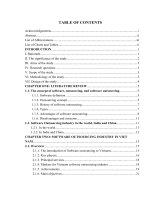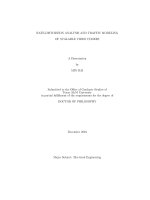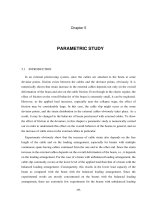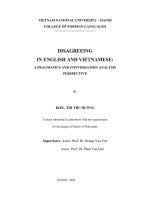Ice bucket challenge campaign analysis
Bạn đang xem bản rút gọn của tài liệu. Xem và tải ngay bản đầy đủ của tài liệu tại đây (52.6 KB, 3 trang )
Course :Advertising Industry Practice COMM2700
Name: Huynh Nha Lam
Student ID: s3651253
Lecturer: Mrs. Thanh Tran
Link webpage: />
ICE BUCKET CHALLENGE
Nowadays, as can be noticed from the news around the world, many social issues
need to be addressed and solved. As a result, many organizations and companies start to
hold campaigns and use them as tactics to spread out the particular messages among
people. In 2014, the Ice Bucket Challenge went viral throughout the social media platforms
and made a huge impact on society’s awareness of Amyotrophic Lateral Sclerosis (ALS)
disease. Soon, not only did the campaign become a trend but it also created many
controversial issues throughout the process. This essay is going to analyze the pros and
cons of the campaign. Besides, several recommendations will be mentioned before coming
to the conclusion.
Specifically, in 2012, the Ice Bucket Challenge was initiated by Pete Frates, alumni of
Boston College. Regarding Braiker (2014), Frates was diagnosed with ALS and he started
posting about the challenge with his father’s help. Before the campaign went viral in 2014,
there were a lot of people not even knowing the existence of ALS. Ice Bucket Challenge was
aimed to make people curious and bring awareness of such disease to the world. Due to
Medrut (2019), people who participated in the campaign have to film and post videos on
social media with the scenario that they have dumped a bucket of ice and water over their
heads. After that, they had to name three other people to do the same challenge in 24 hours
and donate to Amyotrophic Lateral Sclerosis to finish the process. The campaign gained a
lot of donations from the public especially celebrities such as Bill Gates, Oprah, Patrick
Stewart, Taylor Swift, Chris Pratt, etc. Regarding Provoco (2018), even the President Obama
also participated in donating for ALS community. As the campaign went viral and gained
more attention from netizens, people around the world became more creative and
entertaining in making their video content.
According to Boko (2014), some elements make Ice Bucket Challenge one of the
most successful campaigns of the year 2014. Firstly, the simple and clear requirement of
challenge doesn’t take much effort from the audience to understand and participate in the
campaign. Nowadays, people prefer the direct message to the long content posted on the
news or other social media pages. People know that they just need to donate online for the
ALS Association or pouring a bucket of ice over their heads to accomplish the objective of
the challenge. Secondly, the campaign created the opportunity for everyone to get involved
since people could share it on many different social media platforms such as Facebook,
Twitter, Instagram, etc. As a result, this helped the campaign quickly go viral and approach
so many people around the world. Thirdly, the ALS challenge succeeded in making the
multiplier effect. To explain, the participants needed to name and encourage the other three
more people to join them in 24 hours. Therefore, this made them more close to one another
in their network as people were together spreading out the meaningful message and
enjoying the fun of the process.
Despite the huge contribution to the ALS community, the Ice Bucket challenge still
had many controversies during the journey. Throughout the campaign, some might assume
that water shouldn’t be wasted like that. The usage of water in this campaign caused the
concern of negatively affecting the earth. According to page The Atlantic (2014), Jim
Gulliford, executive director of the Soil and Water Conservation Society, argued that it was
also quite sensitive for conducting the campaign when California drought was happening at
that time. On the other hand, there was a phenomenon when people took the challenge
without really knowing the purpose of it. It seemed like they just went with the flow of trend
and showed it on Facebook for fun and attention. Besides, even though many people were
joining in the campaign, not everyone donated for the ALS. As a result, due to Kosinski
(2017), there were those people who called this campaign with the word “slacktivism” to
mention the people had opportunities to show their support to the ALS community but in
reality, they didn’t have much actual contribution to the association. Moreover, after the
campaign, there were many unfortunate accident cases made by people themselves when
they poured a bucket of ice over their heads.
Although the campaign is so successful in making an impact on raising people’s
awareness of ALS, there are some aspects can be improved to achieve a better result. One
of the biggest issues happening in this campaign was the accidents of people joining in Ice
Bucket Challenge. To tackle this issue, the ALS Association can post on their fan page some
advice or recommendations that encourage the audience to carefully prepare things for the
challenge since the safety of activities should be prioritized and focused. This also shows the
caring attitude towards the supporters of the campaign. Another aspect that can be
emphasized in the campaign is the purpose and origin of the challenge. When people filmed
and posted on social media, they didn’t mention much about the ALS disease, the videos
simply went viral because it engaged people and the fun image of participants. If the
campaign can talk more about ALS and spread out more content relevant to the origin of the
challenge, the audience will have more awareness of what they are doing and posting. As a
result, what people are doing will have more meaning to the ALS community and the
campaign can show a more positive image to the world.
To sum up, Ice Bucket Challenge deserves to be nominated as one of the most
outstanding campaigns in the world since it has succeeded in achieving two main goals:
raising people’s awareness of Amyotrophic Lateral Sclerosis (ALS) and raising funds for ALS
community. Nevertheless, with the lack of consideration about the safety of participants and
some other sensitive factors, the campaign also received some negative responses from the
critics. Therefore, the campaign still needs to improve if it wants to create a more positive
perspective to the public.
❖ Reference:
1. Braiker, B 2014, ‘The ‘Ice Bucket Challenge’: A case study in viral marketing gold’,
The Digiday, 14 August, viewed 27 November 2019,
< />2. Boko, G 2014, ‘6 Viral-Marketing Lessons to Learn From the Ice Bucket Challenge’,
The Entrepreneur, 27 August, viewed 27 November 2019,
< />fbclid=IwAR0xtJESoAXFMdCbnt4vmDlzy6QKq1Hh7U5BZjynDTPvvqcONAk90qNsc
XE>
3. Medium 2018, ‘The Success of the Ice-Bucket Challenge’, The Medium, 3 January,
viewed 27 November 2019, < />4. Medrut, F 2019, ‘Remember the Ice Bucket Challenge? What Difference Did It
Actually Make?’, Goalcast, 5 August, viewed 27 November 2019,
< />fbclid=IwAR338cErlDNrsfqWTinGxTkQ93y7edfgI6uw3tfyHwUpUJU1zyGYTG69NRI>
5. Li, S 2014, ‘The California Drought Versus the Ice Bucket Challenge’, The Atlantic,
19 August, viewed 27 November 2019,
< />6. Kosinski, B 2014, ‘#IceBucketChallenge: Why You’re Not Really Helping’, The
Huffpost, 08 July, viewed 27 November 2019,
< />









